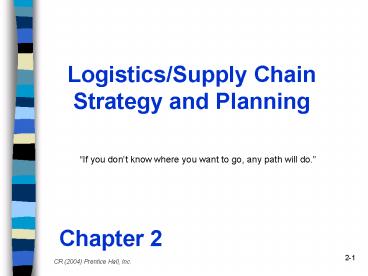Logistics/Supply Chain Strategy and Planning - PowerPoint PPT Presentation
1 / 16
Title:
Logistics/Supply Chain Strategy and Planning
Description:
Logistics/Supply Chain Strategy and Planning If you don t know where you want to go, any path will do. Chapter 2 CR (2004) Prentice Hall, Inc. – PowerPoint PPT presentation
Number of Views:269
Avg rating:3.0/5.0
Title: Logistics/Supply Chain Strategy and Planning
1
Logistics/Supply Chain Strategy and Planning
If you dont know where you want to go, any path
will do.
Chapter 2
CR (2004) Prentice Hall, Inc.
2
Corporate Strategy
Strategy is the process whereby plans are
formulated for
positioning the firm to meet its objectives.
Strategy formulation begins with defining a
corporate
strategy. This involves
a.
Assessing needs, strengths, and weaknesses of the
4
major components
-
customers
-
suppliers
-
competitors
-
the company itself
b.
"Visioning" where counter
-
intuitive, unheard of, and
unconventional strategies are considered.
Corporate strategies are converted to more
specific
strategies for the various functional areas of
the firm such as
logistics.
CR (2004) Prentice Hall, Inc.
3
The objectives of logistics strategy are
- Minimize cost
Logistics Strategy
- Minimize investment
- Maximize customer service
Use ROLA
Levels of logistical planning
- Strategic
- Tactical
- Operational
The 4 problem areas of supply chain planning
- Customer ser
vice levels
Recall the logistics strategy triangle
- Facility location
- Inventory decisions
- Transportation decisions
When to plan?
- No distribution network currently exists.
- There has been no re-evaluation in 5 years.
- When costs are changing rapidly, especially
transport
inventory.
- When markets have shifted.
- When current distribution economics encourage
shifts.
- When there has been a major policy shift in
logistics such as in price,
customer service, or investment level.
4
Corporate to Functional Strategic Planning
CR (2004) Prentice Hall, Inc.
5
Flow of Logistics Planning
CR (2004) Prentice Hall, Inc.
6
Logistics Objective
Maximize return on logistics assets (ROLA)
Costs of logistics operations
Logistics contribution to sales
Investment in logistics assets
CR (2004) Prentice Hall, Inc.
7
Strategic, Tactical, and Operational Decision
Making
Decision area
Strategic
Tactical
Operational
Transportation
Mode selection
Seasonal equip-
Dispatching
ment leasing
Inventories
Location, Control policies
Safety stock levels
Order filling
Order
Order entry, transmittal,
Processing
processing
and processing system
orders, Filling
design
back orders
Purchasing
Development of supplier-
Contracting,
Expediting
buyer relations
Forward buying
Warehousing
Handling equipment
Space utilization
Order picking
selection, Layout design
and restocking
Facility
Number, size, and
location
location of warehouses
2-7
CR (2004) Prentice Hall, Inc.
8
Six Concepts for Logistics Strategy Formulation
CR (2004) Prentice Hall, Inc.
9
A Cost Conflict in Logistics
CR (2004) Prentice Hall, Inc.
10
More Cost Conflicts
2-10
CR (2004) Prentice Hall, Inc.
11
Pure vs. Mixed Strategy
CR (2004) Prentice Hall, Inc.
12
Choosing the Right Supply Chain Strategy
Functional Products--Predictable demand Innovative Products--Unpredictable demand
Efficient supply chain Staple food products
Responsive supply chain Electronic equipment
Low margin
High margin
CR (2004) Prentice Hall, Inc.
13
Classification of Products
Predictable/Mature Products Jello Corn Flakes Lawn fertilizer Ball point pens Light bulbs Auto replacement tires Some industrial chemicals Tomato soup Unpredictable/Introductory Products New music recordings New computer games Fashion clothes Art works Movies Consulting services New product offerings of existing product lines
CR (2004) Prentice Hall, Inc.
14
Choosing the Right Supply Chain Strategy
Efficient supply chain Economical production runs Finished goods inventories Economical buy quantities Large shipment sizes Batch order processing
Responsive supply chain Excess capacity Quick changeovers Short lead times Flexible processing Premium transportation Single order processing
Supply-to-stock
Supply-to-order
15
Actions for Misclassified Products
Product Characteristic
Supply Chain Design Type Predictable/ Mature Unpredictable/ Introductory
Supply-to-Stock/ Efficient Tomato Soup If product is here
Supply-to-Order/ Responsive If product is here Personal Computer Models
CR (2004) Prentice Hall, Inc.
16
Seven Principles of Supply Chain Management
Differentiated distribution
- Segment customers based on service needs
- Listen to signals of market demand and plan
accordingly - Develop a supply-chain-wide technology strategy
- Customize the logistics network
- Differentiate product closer to the customer
- Source strategically
- Adopt channel-spanning performance measures
Design to customer needs
Boundary spanning info. systems
Postponement
Source Accenture Consulting
CR (2004) Prentice Hall, Inc.































